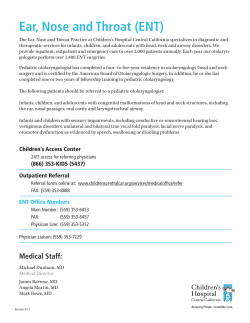
Fracture of nasal bone Etiology Traffic accident Physical combat.
Fracture of nasal bone Etiology Traffic accident Physical combat. Sports injury Nasal bone--- Upper end: thick Lower end: thin Symptoms & Signs:Pain, epistaxis, nasal deformity or deviation, bruising. Diagnosis:X-ray in lateral view. Septal hematoma?——puncture Treatment:Hemostasia, cleaning & suturing wound, restoring alignment Reduction of nasal bone •Before soft tissue edema •5—7 days after injury •Walshan forceps •Nasal packing for 2-3d Deal with septal hematoma & abscess •Septal hemotoma drainage as early as possible. •“L” incision on septum. • Postoperative nasal packing. • Adequate antibiotics. Fracture of frontal bone Pathology:Often combine with fracture of naso-fronto- ethmoido-orbital complex. Front wall Front & back wall Base fracture (frontonasal fracture) Stringy, sunken and smashed fracture Symptoms & Signs: Epistaxis, edema or sunken front. Diagnosis:Frontal palpation, X-ray, CT scans front wall fracture (sunken fracture凹陷型) front & back wall fracture (smashed fracture 粉碎型) Treatment:According to the situation: 1、 stringy fracture 2、 sunken fracture 3、 smashed fracture 4、 front & back wall fracture 5、base fracture (frontonasal fracture): restore the function of frontal sinus. Principle:To isolate the communication between frontal sinus and cranial cavity, to prevent rhinogenic complications, to keep the frontal part from deformation. Fracture of ethmoidal bone Pathology:Often combine with fracture of naso-fronto- ethmoido-orbital complex. Fracture of naso-fronto- ethmoido-orbital complex Symptoms & Signs: Edema of eyelid or nasal root, increase in the intercanthal distance. sunken front , vision disorder, Diagnosis: X-ray film, CT scan Treatment: Vision disorder——depression of optic canal Nosebleed——nasal pack or arterial ligation (ligation of ethmoidal artery) Cerebrospinal fluid rhinorrhea (CSF) —— surgical reparation Blow-out fracture Symptoms & Sign: Swelling and bruising involving all eyelids, lid and infraorbital emphysema. diplopia,restricted movement of the eyes; vision disorder. 击出性骨折 (眶底暴折) Diagnosis: Clinical manifestation, X-ray, CT scans Treatment: Reduction after 7—10d post-wound. Operation approach: via infraorbit, via maxillary sinus and external ethmoidectomy Blow-in fracture Relatively rare. Symptoms & Sign: Protruding eye, swelling eyelids and zygoma, Palpation: infraorbital edge---“stairs-like”. Diagnosis: Clinical manifestation, X-ray, CT scans Treatment: Reduction after 7—10d post-wound. Midface fracture Le Fort , Le Fort , Le Fort Cerebrospinal fluid rhinorrhea (CSF) Etiology: Traumatic: Iatrogenic, and external trauma. Intracranial or extracranial surgery. Cribriform plate, sphinoid, frontoethmoidal complex. Nontraumatic: Spontaneous (or primary), direct erosion or increased intracranial pressure (tumors, congenital or acquired hydrocephalus, or infections. Diagnosis:History, laboratory test, endoscopic examination, ascertain the nature, fix the precise location Treatment: 1、Conservative treatment: To prevent from infection, to prevent from high cranial pressure 2、Surgery: Intracranial approach : Extracranial approach : nasal external approach nasal endoscopic surgery Vestibulitis of nose Etiology: Irritation of rhinorrhea and dust; secondary to skin infection Symptoms & Sign: Red, swelling and ulcerative skin,crusting inside the vestbule, tenderness of the nasal tip or alae. Treatment: Acute——thermotherapy or infrared Chronic——3%H2O2, antibiotic ointment Furuncle of nose Etiology: Secondary to chronic vestibulitis. Diabetics and weaklings will be subject to the disease. Symptoms & Sign: Redness, swelling, heat, and pain; mature—ulcerate. Serious cases: Phlegmon Complications:Thrombosis of cavernous sinus and cranial infection Treatment: Unmature:antibiotic,physiotherapy Mature:drainage,D’not crash and press Ulcerate:drainage,antibiotic Complications:antibiotics,call ophthalmologist and neurologist for assistance Acute & chronic inflammations of the nasal cavities Acute rhinitis Etiology:Rhinoviruses, adenoviruses, coronaviruses, influenza & parainfluenza viruses. Common cord (coryza) Causes: general factors, local factors Symptoms & Sign:Sneezing, nasal obstruction, malaise, fever. Nasal mucosa congestion, swelling, secretion in meatus. Complications: 1、Sinusitis 2、Acute ototitis media infection pass through the Eustachian tube to middle ear 3、Acute pharyngolaryngitis, trachitis & bronchitis Differential Diagnosis: 1、Influenza 2、Allergic rhinitis 3、Vasomotor rhinitis 4、Acute infectious disease Treatment: General treatment Local treatment Chronic rhinitis Etiology: Local causes:1、Acute—→chronic, 2、Chronic diseases of nose & sinus, 3、Infective focus around nasal cavity, 4、 Iatrogenic: misuse nasal drops Professional and environmental causes:dusts, harmful chemical gas,physical changes General factors:1、chronic diseases, 2、malnutrition, 3、endocrinic dysfunction, 4、cigarette and alcohol Pathology: Simple chronic rhinitis——no hyperplasia Hypertrophic chronic rhinitis——nasal mucosa, submucosa, even periosteum & os: limited or extensive hypertrophy Symptoms & Sign: Nasal obstruction, rhinorrhea, hypertrophied inferior turbinate Treatment: 1、Pathogenic treatment 2、Local treatment 1) Simple chronic rhinitis: Vasoconstrictor sympsthomimetics, acupuncture 2) Hypertrophic chronic rhinitis: Vasoconstrictor sympsthomimetics, electric coagulation, laser, microwave, radiofrequancy. Partial inferior turbinectomy. 单纯性鼻炎 肥厚性鼻炎 鼻塞 间歇性 持续性 鼻涕 黏液性 多,黏液性或粘 脓性,不易擤出 闭塞性鼻音 无 有 前鼻镜检查 下甲黏膜肿胀,表 下甲黏膜肥厚,表 面光滑 面可呈结节状 下鼻甲探针触诊 柔软,有弹性 硬实感 对麻黄素反应 黏膜收缩明显 黏膜收缩不明显 治疗 非手术治疗 宜手术治疗 Atrophic rhinitis Etiology: Primary:Endocrine imbalance, functional disorders of autonomic nerve, infection, (coccobacillus foetidus ozena, diphtheroid bacilli), poor nutrition, hereditary factors, autoimmunophathy? Secondary:1)Infection:chronic inflammation; 2)Iatrogenic: excessive surgical destruction of mucosa (empty nose syndrome); 3)Irritant: 4)Special infection: tuberculosis, syphilis. Pathology:Endarteritis and periarteritis of terminal arterioles, metaplasia of the epithelium, atrophy of the mucosa, glands, periosteum. Symptoms & Sign: 1)Nose, nasopharynx is dry 2)Nasal obstruction (detached crusts) 3) Epistaxis 4) Anosmia 5) Foul or fetid odor 6) Headache Treatment: 1、Local management:nasal irrigation by worm water, liquid paraffin 2、 General management:vitaminB2、C、E 3、 Surgery:
© Copyright 2025















